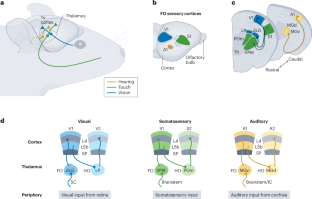Sensory modality-specific wiring of thalamocortical circuits
IF 26.7
1区 医学
Q1 NEUROSCIENCES
引用次数: 0
Abstract
The thalamus is an essential element for sensory information processing, serving as a link between peripheral sensory stimuli and cortical circuits. Consequently, the development of thalamocortical (TC) projections has been a central focus in systems neuroscience. Although substantial progress has been made in understanding the mechanisms guiding thalamic axon navigation from the diencephalon to the cortex, our understanding of the processes underlying sensory modality specificity in TC circuits remains incomplete. Modern genomic, physiological and imaging approaches have yielded exciting results, providing novel insights into the specialization of visual, somatosensory and auditory TC circuits. Recent findings have shed light on the genetic and spontaneous activity mechanisms involved in the formation of distinct sensory modalities, rekindling the interest in the thalamus and opening new research perspectives on the development of this diencephalic structure. The use of transcriptomic technologies has led to advances in our understanding of thalamocortical targeting during development. In this Review, Guillamón-Vivancos et al. discuss these advances in the context of how transcriptomic changes and neuronal activity work in concert to drive sensory modality specificity during the development of thalamic sensory nuclei.


丘脑皮层回路的感觉模式特异性布线
丘脑是感觉信息处理的重要组成部分,是连接周围感觉刺激和皮层回路的纽带。因此,丘脑皮质(TC)投射的发展一直是系统神经科学的中心焦点。尽管在了解丘脑轴突从间脑到皮层的导航机制方面取得了实质性进展,但我们对TC回路中感觉模式特异性的过程的理解仍然不完整。现代基因组学、生理学和成像方法已经取得了令人兴奋的结果,为视觉、体感和听觉TC回路的专业化提供了新的见解。最近的研究结果揭示了不同感觉模式形成的遗传和自发活动机制,重新点燃了对丘脑的兴趣,并为这种间脑结构的发展开辟了新的研究视角。
本文章由计算机程序翻译,如有差异,请以英文原文为准。
求助全文
约1分钟内获得全文
求助全文
来源期刊

Nature Reviews Neuroscience
NEUROSCIENCES-
自引率
0.60%
发文量
104
期刊介绍:
Nature Reviews Neuroscience is a multidisciplinary journal that covers various fields within neuroscience, aiming to offer a comprehensive understanding of the structure and function of the central nervous system. Advances in molecular, developmental, and cognitive neuroscience, facilitated by powerful experimental techniques and theoretical approaches, have made enduring neurobiological questions more accessible. Nature Reviews Neuroscience serves as a reliable and accessible resource, addressing the breadth and depth of modern neuroscience. It acts as an authoritative and engaging reference for scientists interested in all aspects of neuroscience.
 求助内容:
求助内容: 应助结果提醒方式:
应助结果提醒方式:


